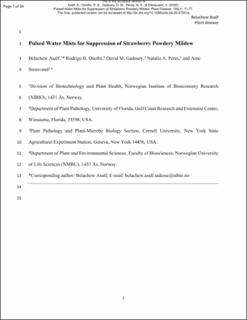| dc.contributor.author | Asalf, Belachew | |
| dc.contributor.author | Onofre, Rodrigo B. | |
| dc.contributor.author | Gadoury, David M. | |
| dc.contributor.author | Peres, Natalia A. | |
| dc.contributor.author | Stensvand, Arne | |
| dc.date.accessioned | 2021-02-18T15:32:47Z | |
| dc.date.available | 2021-02-18T15:32:47Z | |
| dc.date.created | 2020-09-15T18:34:33Z | |
| dc.date.issued | 2020-11-11 | |
| dc.identifier.citation | Plant Disease. 2020, 105 (1), 71-77. | en_US |
| dc.identifier.issn | 0191-2917 | |
| dc.identifier.uri | https://hdl.handle.net/11250/2729036 | |
| dc.description.abstract | Powdery mildew (Podosphaera aphanis) is a destructive and widespread disease of strawberry (Fragaria × ananassa), especially when susceptible cultivars are grown in high plastic tunnels or glasshouses. Many powdery mildews thrive in humid environments but free water films on plant surfaces can inhibit conidial germination of some species. We hypothesized that P. aphanis might be directly suppressed by rain through the action of water films and meteoric water. In repeated experiments, the hydrophobic conidia of P. aphanis collected on the surface of water droplets, resulting in their removal when the droplets rolled over the leaf surfaces and fell to the ground. Meteoric water and water films also damaged conidiophores. Brief midday water mists applied in pulses lasting 1 min each four times per day were as effective as multiple fungicide treatments in suppressing powdery mildew. Rapid drying of the pulsed mists resulted in effective suppression of powdery mildew without consequent increases of fungal pathogens that might benefit from water films. The timing and duration of water sprinkling has been refined to the point where it can provide a commercially relevant degree of suppression of powdery mildew on strawberry in a high-tunnel production system. | en_US |
| dc.language.iso | eng | en_US |
| dc.publisher | APS Publications | en_US |
| dc.title | Pulsed Water Mists for Suppression of Strawberry Powdery Mildew | en_US |
| dc.type | Peer reviewed | en_US |
| dc.type | Journal article | en_US |
| dc.description.version | acceptedVersion | en_US |
| dc.rights.holder | © 2021 The American Phytopathological Society | en_US |
| dc.source.pagenumber | 71-77 | en_US |
| dc.source.volume | 105 | en_US |
| dc.source.journal | Plant Disease | en_US |
| dc.source.issue | 1 | en_US |
| dc.identifier.doi | 10.1094/pdis-04-20-0735-re | |
| dc.identifier.cristin | 1830224 | |
| dc.relation.project | Norges forskningsråd: 244526 | en_US |
| dc.relation.project | Landbruksdirektoratet: 225254 | en_US |
| cristin.ispublished | true | |
| cristin.fulltext | postprint | |
| cristin.qualitycode | 1 | |
